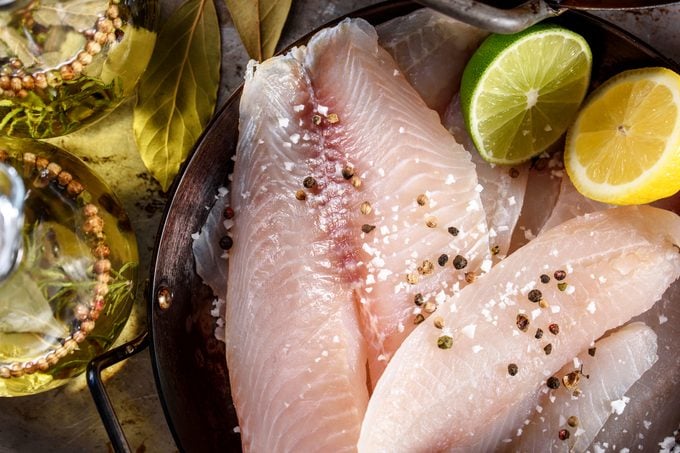8 Things to Know About Tilapia Nutrition
Updated: Mar. 08, 2022
Is this popular fish good for you? Dietitians explain the nitty gritty facts of tilapia nutrition.
Tilapia 101
How much do you know about tilapia? Whether you’re old friends with the white fish or are unfamiliar it, you’ll want to cook with often. Why?
“Tilapia is a relatively inexpensive source of lean protein,” says Rebecca Valdez, a registered dietitian nutritionist in Phoenix, Arizona. “It’s high in protein and unsaturated fats, and is low in saturated fat.”
It’s also fairly low in mercury, which means it’s a top seafood pick.
Now, let’s dig into all the tilapia nutrition facts you’ve ever wanted to know—as well as tips for preparing the fish.
Different types of tilapia
Tilapia comes from all over the world. You’ll find blue tilapia from Peru and Taiwan; hybrid red tilapia from Ecuador, Taiwan, and Colombia; Mozambique tilapia from Taiwan and China; hybrid tilapia from China; Nile tilapia from Ecuador, Colombia, Honduras, Mexico, Taiwan, Indonesia, and China; Sabaki tilapia from Taiwan; and Wami tilapia from Taiwan.
“Most tilapia available today is farm raised, meaning that where it was raised and how it was fed can affect its quality, including the nutrient content and level of contaminants,” says Valdez. The fish survives well in outdoor ponds, as well as high-tech tank systems.
Where tilapia comes from
Tilapia originally came from Mediterranean and African countries, according to the Florida Department of Agriculture and Consumer Services.
In addition to purchasing tilapia that originates in the United States, you can buy tilapia from other countries. These include Ecuador and Peru.
In fact, the Monterey Bay Aquarium Seafood Watch advises buying tilapia that comes from Peru raceways and Ecuadorian ponds. Tilapia from Colombia, Honduras, Mexico, Indonesia, and Taiwan are also considered good choices.
However, the Monterey Bay Aquarium Seafood Watch advises not purchasing tilapia from China, as illegal antibiotics may be used, and evidence of antibiotic resistance exists. To purchase sustainable tilapia, look for the Marine Stewardship Council blue label on a product’s package.

Tilapia benefits
When it comes to nutrition, tilapia has a lot going for it. “A 3-ounce serving provides over 100 milligrams of EPA and DHA omega-3 fatty acids,” says registered dietitian nutritionist Rosanne Rust, author of DASH Diet For Dummies in Venice, Florida.
These omega-3s are important for helping to reduce inflammation—as well as for helping both heart and brain health.
Another huge benefit of tilapia: It’s an excellent source of vitamin D, important for both immune and bone health. Not many foods provide ample vitamin D, so this is a big deal.
“Tilapia is also a great source of vitamin B12, an essential nutrient for DNA production that helps keep your blood and nerve cells functioning properly,” notes registered dietitian nutritionist Grace Clark-Hibbs, owner of Nutrition with Grace in Portland, Oregon.
Tilapia and disease prevention
You’ll get many disease-fighting benefits from the EPA and DHA omega-3s that tilapia provides.
“A comprehensive review in 2018 found strong evidence that omega-3 fatty acids can help reduce triglyceride levels in the blood and help increase HDL (good) cholesterol,” says Clark-Hibbs.
“This suggests that omega-3 fatty acids are beneficial to the heart when paired with an overall healthy diet and lifestyle but cannot solely prevent heart disease.”
Additionally, a 3-ounce serving of tilapia provides almost all the selenium you’ll need in a day. What this means: “Eating tilapia may support thyroid health,” says registered dietitian nutritionist Anne Danahy, owner of Craving Something Healthy in Scottsdale, Arizona.
“Your body needs the selenium to make thyroid hormone. A study in the journal Nutrients on more than 14,000 people found that subjects who got more selenium in their diet had a lower risk of hypothyroidism, aka underactive thyroid disease.”
As well, because tilapia provides an excellent amount of protein—23 grams per 3-ounce serving—for a relatively low amount of calories, it’s a great choice for older adults who have small appetites.
“Because it’s so lean, it’s less filling than oily fish like salmon,” says Rust. “Older adults may benefit from getting more protein at each meal to help reduce the risk of age-related muscle loss.”
Tilapia nutrition facts
“Tilapia is a bargain in terms of calories, and it’s also packed with protein,” says Danahy. Here are the nutrition facts for tilapia—including the Daily Values (DVs)—for a 3.1-ounce cooked serving.
Calories: 111
Total Fat: 2.3 g (3 percent DV)
Protein: 22.8 g (46 percent DV)
Carbs: 0 g (0 percent DV)
Sodium: 48.7 g (2 percent DV)
Iron: .6 g (3 percent DV)

How much tilapia to eat
Let’s hear it for tilapia!
“Tilapia is one of the FDA’s and EPA’s ‘best choice’ fish because it has lower levels of mercury and other contaminants, compared with other types of fish,” says Valdez. “This means that one serving of three to four ounces can be consumed safely two to three times per week, as part of a healthy eating pattern.”
Tilapia’s low mercury levels also make it a good choice for pregnant and lactating women.
Of course, you ideally should consume a variety of seafood—not just tilapia. The 2020-2025 Dietary Guidelines for Americans advise that adults should aim for two 4-ounce servings of seafood per week, although many experts recommend consuming up to 12 ounces per week.
“The dietary guidelines recommend focusing on seafood that is lower in mercury and higher in omega-3 and omega-6 fatty acids, which includes tilapia,” says Clark-Hibbs.
Risks and side effects of tilapia
As with any seafood, you’ll want to use a tool such as the Monterey Bay Aquarium Seafood Watch to choose tilapia that is not a risk to your health or to the environment.
“The top concerns for fish are mercury, polychlorinated biphenyls (PCBs), dioxins, and pesticide residues,” says Valdez.
“At very high levels, these contaminants may damage nerves in adults or disrupt nerve and brain development in a fetus or young child. Tilapia contains one of the lowest levels of contaminants because of its small size and low level on the food chain.”
How to eat tilapia
Because tilapia is a white fish with a mild flavor, it’s a great blank canvas for seasonings and sauces. “It can be pan fried, baked, air fried, grilled, or steamed,” says Valdez. Give these tilapia recipes, all created by registered dietitians, a try:
- Baja Fish Tacos from Danahy
- Blackened Tilapia with Mango Avocado Slaw from Megan Byrd, RD
- Fish with Easy Lemon Garlic Sauce from Elysia Cartlidge, RD



















